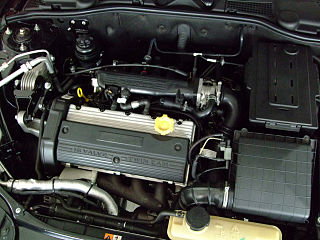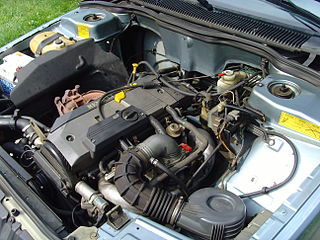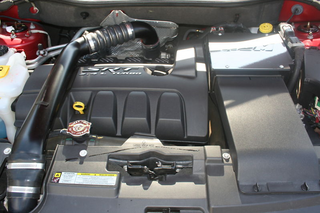
The Standard Motor Company Limited was a motor vehicle manufacturer, founded in Coventry, England, in 1903 by Reginald Walter Maudslay. For many years, it manufactured Ferguson TE20 tractors powered by its Vanguard engine. All Standard's tractor assets were sold to Massey Ferguson in 1959. Standard purchased Triumph in 1945 and in 1959 officially changed its name to Standard-Triumph International and began to put the Triumph brand name on all its products. A new subsidiary took the name The Standard Motor Company Limited and took over the manufacture of the group's products.

The Rover K-series engine is a series of internal combustion engines built by Powertrain Ltd, a sister company of MG Rover. The engine was a straight-four cylinder built in two forms, SOHC and DOHC, ranging from 1.1 to 1.8 L; 67.9 to 109.6 cu in.

Coventry Climax was a British forklift truck, fire pump, racing, and other speciality engine manufacturer.
The GM Ecotec engine, also known by its codename L850, is a family of all-aluminium inline-four engines, displacing between 1.4 and 2.5 litres. Confusingly, the Ecotec name was also applied to both the Buick V6 Engine when used in Holden Vehicles, as well as the final DOHC derivatives of the previous GM Family II engine; the architecture was substantially re-engineered for this new Ecotec application produced since 2000. This engine family replaced the GM Family II engine, the GM 122 engine, the Saab H engine, and the Quad 4 engine. It is manufactured in multiple locations, to include Spring Hill Manufacturing, in Spring Hill, Tennessee, with engine blocks and cylinder heads cast at Saginaw Metal Casting Operations in Saginaw, Michigan.

The Rover V8 engine is a compact V8 internal combustion engine with aluminium cylinder block and cylinder heads, originally designed by General Motors and later re-designed and produced by Rover in the United Kingdom. It has been used in a wide range of vehicles from Rover and other manufacturers since its British debut in 1967.

The Ferrari Colombo Engine was a petrol fueled, water cooled, carburetted 60° V12 engine designed by Gioacchino Colombo and produced in numerous iterations by Italian automaker Ferrari between 1947 and 1988. The maker's first homegrown engine, its linear successor is the Lampredi V12, which it far outlived, the last Lampredi being made in 1959.
The Honda B20A engine series, known as the B20A and B21A, was an inline four-cylinder engine family from Honda introduced in 1985 in the second-generation Honda Prelude. Also available in the contemporary third-generation Honda Accord in the Japanese domestic market, along with the Accord-derived Vigor, the B20A was Honda's second line of multivalve DOHC inline four-cylinder engines behind the "ZC" twin-cam variant of the ordinarily SOHC D-series, focused towards performance and displacing 2.0 to 2.1 litres.

The E-series was a line of inline four-cylinder automobile engines designed and built by Honda for use in their cars in the 1970s and 1980s. These engines were notable for the use of CVCC technology, introduced in the ED1 engine in the 1975 Civic, which met 1970s emissions standards without using a catalytic converter.

The J-series is Honda's fourth production V6 engine family introduced in 1996, after the C-series, which consisted of three dissimilar versions. The J-series engine was designed in the United States by Honda engineers. It is built at Honda's Anna, Ohio, and Lincoln, Alabama, engine plants.

The Austin Motor Company A-series is a British small straight-4 automobile engine. Launched in 1951 with the Austin A30, production lasted until 2000 in the Mini. It used a cast-iron block and cylinder head, and a steel crankshaft with three main bearings. The camshaft ran in the cylinder block, driven by a single-row chain for most applications, and with tappets sliding in the block, accessible through pressed steel side covers for most applications, and with overhead valves operated through rockers. The cylinder blocks are not interchangeable between versions intended for conventional end-on mounted gearboxes and the 'in-sump' transaxle used on British Motor Corporation/British Leyland front wheel drive models such as the Mini. The cylinder head for the overhead-valve version of the A-series engine was designed by Harry Weslake – a cylinder head specialist famed for his involvement in SS (Jaguar) engines and several Formula One-title winning engines. Although a "clean sheet" design, the A-series owed much to established Austin engine design practise, resembling in general design and overall appearance a scaled-down version of the 1200cc overhead-valve engine first seen in the Austin A40 Devon which would form the basis of the later B-series engine.

The Ferguson TE20 is an agricultural tractor designed by Harry Ferguson. By far his most successful design, it was manufactured from 1946 until 1956, and was commonly known as the Little Grey Fergie. It marked a major advance in tractor design, distinguished by light weight, small size, manoeuvrability and versatility. The TE20 popularised Harry Ferguson's invention of the hydraulic three-point hitch system around the world, and the system quickly became an international standard for tractors of all makes and sizes that has remained to this day. The tractor played a large part in introducing widespread mechanised agriculture. In many parts of the world the TE20 was the first tractor to be affordable to the average farmer and was small and light enough to replace the draft horse and manual labour. Many TE20s remain in regular use in farming and other work and the model is also a popular collector's item for enthusiasts today.

The Suzuki G engine is a series of three- and four-cylinder internal combustion engines manufactured by Suzuki Motor Corporation for various automobiles, primarily based on the GM M platform, as well as many small trucks such as the Suzuki Samurai and Suzuki Vitara and their derivatives.

The PSA XU is a family of internal combustion engines used in Citroën and Peugeot automobiles. It became the dominant mid-size engine in Peugeot and Citroën products through the 1980s and 1990s.

The Douvrin family is an all-aluminum inline-four automobile engine designed in the early 1970s and produced from 1977 to 1996 by Compagnie Française de Mécanique, a joint-venture between PSA and Renault located in the town of Douvrin in northern France. This engine is designed by the engineer Jean-Jacques His. It was produced in the same factory as the PRV V6, which also is sometimes known outside France as the "Douvrin" V6. The Douvrin engine is also referred to as the ZDJ/ZEJ engine by Peugeot, and as the J-type engine by Renault.

The Lotus-Ford Twin Cam is an inline-four petrol engine developed by Lotus for the 1962 Lotus Elan. A few early examples displaced 1.5 litres, but the majority were 1.55-litre (1557cc) engines. It used a Ford 116E iron cylinder block and a new aluminium cylinder head with dual overhead camshafts. The Twin Cam was used in a variety of vehicles until Lotus stopped production in 1973. It was succeeded by the Lotus 907 engine.

The Standard Vanguard is a car which was produced by the Standard Motor Company in Coventry, England, from 1947 until 1963.

The EA827 family of petrol engines was initially developed by Audi under Ludwig Kraus leadership and introduced in 1972 by the B1-series Audi 80, and went on to power many Volkswagen Group models. This is a very robust water-cooled engine configuration for four- up to eight- cylinders. In Brazil this engine was produced under the name Volkswagen AP AP.

The World Gasoline Engine is a family of straight-4 piston engines, based on the Global Engine Alliance design.

The Standard SC engine is a cast-iron overhead valve straight-four engine designed and initially produced by Standard Triumph. Over its production life displacement grew from an initial size of just over 800 cc to nearly 1500 cc. Introduced in the Standard Eight in 1953, it would eventually be used in a wide range of vehicles from Standard, Triumph, and MG.





















